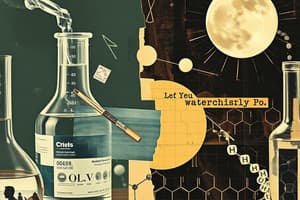Podcast
Questions and Answers
What are the starting molecules of a chemical reaction called?
What are the starting molecules of a chemical reaction called?
- Products
- Neutrons
- Protons
- Reactants (correct)
Which process involves the conversion of carbon dioxide and water to glucose and oxygen?
Which process involves the conversion of carbon dioxide and water to glucose and oxygen?
- Oxidation
- Fermentation
- Respiration
- Photosynthesis (correct)
What do the opposite-headed arrows in a chemical reaction indicate?
What do the opposite-headed arrows in a chemical reaction indicate?
- Endothermic reaction
- Irreversible reaction
- Reversible reaction (correct)
- Exothermic reaction
At chemical equilibrium, what happens to the relative concentrations of reactants and products?
At chemical equilibrium, what happens to the relative concentrations of reactants and products?
Which term refers to the making and breaking of chemical bonds?
Which term refers to the making and breaking of chemical bonds?
In a chemical equation, what do the numbers in front of the reactants and products represent?
In a chemical equation, what do the numbers in front of the reactants and products represent?
What type of bond is formed when electrons are not evenly distributed, leading to attractions between molecules that are close together?
What type of bond is formed when electrons are not evenly distributed, leading to attractions between molecules that are close together?
Which type of interaction involves a hydrogen atom attracted to an electronegative atom in living cells?
Which type of interaction involves a hydrogen atom attracted to an electronegative atom in living cells?
What is the resulting charged atom when an electron is stripped by its bonding partner?
What is the resulting charged atom when an electron is stripped by its bonding partner?
Which type of bond involves the attraction between anions and cations?
Which type of bond involves the attraction between anions and cations?
In which type of reaction can weak bonds provide an advantage due to their reversibility?
In which type of reaction can weak bonds provide an advantage due to their reversibility?
Which type of interaction occurs between molecules that are close together as a result of uneven electron distribution?
Which type of interaction occurs between molecules that are close together as a result of uneven electron distribution?
What is the definition of an element?
What is the definition of an element?
Which of the following elements make up 96% of living matter?
Which of the following elements make up 96% of living matter?
What are trace elements?
What are trace elements?
How would you define compounds?
How would you define compounds?
What is the key characteristic of compounds compared to their constituent elements?
What is the key characteristic of compounds compared to their constituent elements?
Which substances make up the majority of the remaining 4% of living matter?
Which substances make up the majority of the remaining 4% of living matter?
Flashcards are hidden until you start studying




